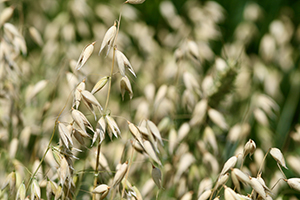Entire oat genome mapped
After many years, a research team led by Lund University in Sweden has sequenced and characterized the entire genome of oats. This opens up for breeding healthier oats with even better nutritional content, and growing oats in a more environmentally sustainable way. The detailed genetic analyzes also strengthen the evidence that oats are safe in a gluten-free diet. The results are published in Nature.
– Published 18 May 2022

The project has taken many years as the oat genome is very complex. One explanation is that oats are a so-called hexaploid, which means that it has six chromosome sets out of seven chromosomes – compared with, for example, the human genome which is diploid and thus has two chromosomes of each kind. Oat chromosome architecture is more complicated than other grains, with over 80,000 genes that must be sorted correctly (compared to approximately 20,000 genes in humans).
“This has been a huge project. There are so many copies of the same genes, and it has been difficult to place the genes correctly in each chromosome. It's like Lego pieces that have to fit together correctly, which is difficult because the genome has been "jumbled around" so much compared to other grains. However, now we have this map of the oat genome, which means we can develop oats and increase the understanding of its useful properties”, says Nick Sirijovski, researcher in applied biochemistry at Lund University and lead author.
A solid foundation to develop oat varieties
The first raw sequence for the genome consisted of 17 billion small DNA fragments. This enormous amount of data corresponds to the entire oat genome 270 times over. These pieces then needed to be put together in much longer fragments and eventually as whole chromosomes.
“This research lays a solid foundation to develop oat varieties with higher yields, better climate resilience, improved nutritional properties and increased sustainability”, says Olof Olsson, professor of applied biochemistry at Lund University.
Global demand for oats and oat products is increasing rapidly, with consumers eating a more plant-based and health conscious diet.
New varieties of oats
By mapping the genome, it becomes easier to establish which part is linked to certain specific properties. This in turn makes it easier to understand how to single out desirable traits in new oat varieties - and also how to avoid weaknesses as well. The difficulty lies in the fact that oats have six chromosome sets of their seven chromosomes (42 chromosomes in total), so each copy of the gene you want to affect must be identified for a novel trait to take hold in a new variety.
“Among other things, it is interesting to study beta-glucan, which is a water-soluble dietary fiber with a cholesterol-lowering effect that is good for preventing cardiovascular disease. The hope is to be able to produce new varieties of oats with a high content of beta-glucan”, says Alf Ceplitis, CEO of CropTailor AB and one of the co-authors of the article.
Oats also have an interesting protein content, and contain a much larger proportion of essential amino acids compared to many other crops.
Safe to include oats in gluten-free diets
Analyzes of the prolamin storage proteins in oat seeds, that are equivalent to gluten proteins in wheat, has also shown that they occur at much lower levels and are encoded by fewer gene copies than in wheat and barley.
“This increases our knowledge on why you can eat pure oats without getting an autoimmune reaction if you suffer from celiac disease, which confirms that it is safe to include oats in gluten-free diets”, says Nick Sirijovski.
The mapping of the oat genome also makes it possible to transfer knowledge from other crops more quickly to new and improved oat varieties.
“An example of how the genome is used today is the search for oat varieties without genes that produce enzymes that break down fats post-harvest. The goal is to develop new oat varieties that do not, like today, need heat treatment before they are used in various products”, concludes Sofia Marmon, researcher in applied biochemistry.
About the study:
The study is a collaboration between 29 researchers from 20 institutions in five countries, with extensive collaboration between ScanOats researchers and Helmholtz Center Munich in Germany.
ScanOats is an industry research center with involvement from Lantmännen, Oatly and Swedish Oat Fiber, Lund University, Swedish University of Agricultural Sciences and RISE.
Nick Sirijovski conducted the research while working as a researcher at CropTailor AB and at Lund University as well as ScanOats. He is currently employed at Oatly and an affiliated researcher in applied biochemistry at Lund University. In addition to Nick Sirijovski and Olof Olsson, Nikos Tsardakis Renhuldt (doctoral student) and Johan Bentzer (bioinformatician) at ScanOats have also worked on the project.
The project has been funded by Stiftelsen för Strategisk Forskning (SSF), CropTailor AB, Lantmännen's Research Foundation and ScanOats.
